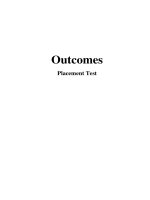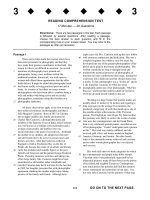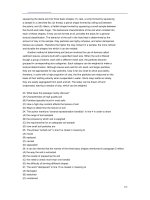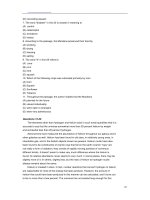reading placement test info
Bạn đang xem bản rút gọn của tài liệu. Xem và tải ngay bản đầy đủ của tài liệu tại đây (437.65 KB, 12 trang )
Accuplacer Reading Placement Test
Please look through this webpage for detailed information concerning effective college reading and
taking the reading placement exam. There are many links and resources here designed to prepare
students for the Reading Placement Test. It is highly recommended that students review this material
and seek assistance to ensure that they are placed into the appropriate class.
Information about scheduling your test is at the bottom of this webpage.
Why Do I Have to Take a Reading Placement Test?
Reading is a big part of the college experience. Most professors use books in their classrooms
and expect students to learn from them as part of the learning process. CSN has implemented
mandatory reading placement testing as a means to ensure all students are prepared for the
reading demands of their academic program. If you place above the reading classes, then you
can feel confident that you will be able to read and learn from your college level material with
success. If you place into one of the reading classes, you can feel confident that the reading
instructors will equip you with the reading and study strategies you will need to be successful in
your college courses.
About the Accuplacer Reading Placement Test
The Accuplacer reading comprehension test measures how well the student understands what
he/she reads.
Some questions are of the sentence relationship type in which one must determine how
two sentences are related.
Other questions assess the ability to distinguish between main and secondary points
and making simple deductions from a series of facts.
Specific skills to be tested are in the areas of main ideas, supporting details, words in
context, author’s purpose and tone, relationships within and between sentences, fact
and opinion, inferences, and conclusions.
There are 20 reading comprehension questions on the Accuplacer test.
To learn more about the Accuplacer test and view sample questions please visit the link below.
/>
What Does My Score Mean?
Beginning Fall Semester -2016, English 100/101/113 will use a Reading Requirement
Prerequisite. This means, if you do not score 86 or higher on your test, you will need to take
advantage of our Reading Support programs before you can enroll in English 100/101/113.
*Most classes require students to complete English 100/101/113 as a prerequisite.
CSN offers 3-unit classes, 1-unit classes, and the Reading Center as pathways for students to
improve their reading.
*After taking the test you will receive a score somewhere between 0 and 120. A student who
can read college level material efficiently would score 100 or higher.
A score below 56 points: This is an indication that you will experience extreme
difficulty reading college level material. CSN can help you strengthen your reading skills before
you retake the Accuplacer Reading Placement test. CSN options are listed below.
READ 99: Accuplacer IMOPROVEMENT LEVEL 1: This is a one unit, online reading
intervention workshop. Students will earn a letter grade to complete this 8-week
course. Students will need to retake the Accuplacer Reading Placement Test.
READING CENTER: A Reading Assistant will work through an individualized learning
plan with you, and help you prepare to retake the Accuplacer test.
A score between 56 and 70 points: This is an indication that you will experience
substantial difficulty reading college level material. CSN can help you strengthen your reading
skills before you retake the Accuplacer Reading Placement test. CSN options are listed below.
Reading 95: This class will improve fundamental reading skills, including word-attack
skills, vocabulary development, reading comprehension, fluency, and
interpretation. Extensive opportunities for applying reading strategies for before,
during, and after reading will be provided. Critical analysis skills in relationship to
various texts will be introduced to guide students toward college level
reading. Students who pass this course may register for READ 130 or READ 135.
Reading 99: Accuplacer Improvement LEVEL 2: This is a one unit, 8 week online course.
Students will earn a letter grade and must retake the Accuplacer.
CSN Reading Center: A Reading Assistant will work through an individualized learning
plan with you, and help you prepare to retake the Accuplacer test.
A score between 71 and 85 points:
This is an indication that you will experience
moderate difficulty reading college level material. CSN can help you strengthen your reading
skills before you retake the Accuplacer Reading Placement test. CSN options are listed below.
Reading 135: (3 UNITS) Improvement of reading comprehension, critical thinking skills,
vocabulary, reading rate, and study reading techniques through reading and analyzing a
variety of texts, including book-length works and textbook selections from various areas.
*Students who pass this course with a “C” may register for English 100/101/113.
Reading 130: (3 UNITS) Students will learn the unique skills required to read textbooks
and related materials in different subject areas. Students will learn how to adapt and
apply academic reading strategies to suit distinct characteristics texts in academic
disciplines. *Students who pass this course with a “C” may register for English
100/101/113.
Reading 99: Accuplacer Improvement Level 3: This is a one unit, 8 week online course.
Students will earn a letter grade and must retake the Accuplacer.
CSN Reading Center: A Reading Assistant will work through an individualized learning
plan with you, and help you prepare to retake the Accuplacer test.
A score above 85 points: This is an indication that you may be prepared to read college
level material. No reading classes will be recommended and you will be free to enroll in English
100/101/113.
Preparing for the Accuplacer Reading Placement Test
The College of Southern Nevada offers various resources at every campus to help you become prepared
for this test.
The Reading Center
/>
The Reading Centers are located in the Writing Centers at the West Charleston, Cheyenne, and
Henderson campuses. A specially trained Reading Assistant is available to provide CSN students
with free and unlimited support. Students can work on practice Accuplacer tests with the
reading assistant. Students can also work through an individually prepared reading
improvement plan and get training in using active reading strategies.
The Library
/>
The library has digital and printed resources to help you prepare for the reading placement test.
Please follow this link to see the many resources available.
Online Student Success Workshops
All CSN students have access to the Student Lingo Online Student Success Workshops. These
workshops can be accessed through your MYCSN page.
Reading Comprehension Strategies
Sample Reading Test from Passaic County Community College
Click on the link below and take this sample reading test to get an idea of what type of passages
you can expect when you come in for your test.
/>
More Accuplacer Sample Reading Tests
CSN recommends that students spend several hours preparing to take the Reading Placement
Test. More sample reading tests are provided below.
/> />ests/Accuplacer/Reading%20Comprehension/Pages/default.aspx
Videos about taking the Accuplacer Reading Comprehension Test
The following videos are available to help you understand the different types of questions that
you will encounter as you take the Reading Placement Test.
(4 minutes) Accuplacer Reading
Comprehension; Question Forms
(3
minutes) Accuplacer Reading Comprehension; secondary and supporting ideas.
(3
minutes) Accuplacer Reading Comprehension; applications
(3
minutes) Accuplacer Reading Comprehension; identifying main ideas
(3
minutes) Accuplacer Reading Comprehension; inferences
(4 minutes) Accuplacer Reading
Comprehension Test - Understanding Fact or Opinion
Videos about Improving Reading Comprehension
These videos will give you a good idea of what is expected with college-level reading.
(38 minutes) How to Improve Your Reading
Comprehension
(11 minutes) Reading Skills that Work - for
Tests and In-Class
/>Accuplacer Reading Review: This link (above) has several short videos about varied reading
topics and strategies; Be an Active Reader, Bias and Stereotype, Circular Reasoning, Drawing
Conclusions from Graphic Organizers, Fact or Opinion, False Analogy, False Dichotomy,
Historical Context, Inductive and Deductive Reasoning, Overgeneralization, Plotline, Reading
Comprehension Tips, Textual Evidence for Prediction, Textual Support for Interpretation, and
Topics and Main Ideas.
Some Helpful Hints about Taking the Test
This is not a time to “speed read”. Doing well on this test could save you hundreds; potentially
thousands of dollars in tuition fees, book orders, and lost income.
When you sit down to take this test, enjoy the reading; visualize the passage and try to
relate what you read to your life and what you already know about the information.
Read the first sentence, or the title of a passage, and think for 5 seconds about the topic
before you start to read.
Try first to determine the topic of the passage.
Look very carefully at the supporting details being provided.
Think about how the supporting details relate to the main idea.
Don’t be afraid to reread the passage. The test is not timed.
Sometimes it is helpful to read the questions first.
Look for transition words to help focus on key details and understand the main idea.
Clear your mind before you take the test.
Eliminate Internal Distractions
It is extremely important that you come to the test with a clear mind that can focus on the
reading test. Make sure you get plenty of rest, eat well, and feel relatively stress free. If for
instance, something stressful happens on the day you are to take the test, or you are
stressed out or ill, it would be better to reschedule than to take the test in a frantic state of
mind.
Internal distractions are the concerns that come into your mind while you are trying to read.
These may be chores, memories, or important items to cross off your to-do list. It is
important that you are clear from these thoughts during the test. To keep your mind off of
these distractions, have a list prepared of all the things that you need to do or to think
about and keep it for after the test.
It is equally important that when you do come in for your test that you feel confident. Have
a positive attitude and remember you are a beginning college student who has already
accomplished many great things in life. You are making great decisions and your life is only
going to get better. Don’t let negative self-talk interfere with your ability to concentrate
and comprehend the reading passages.
Perhaps most importantly, you must reduce your anxiety. Nervous tension will be
distracting and may interfere with your ability to concentrate. Some people like to exercise
or meditate to gain control of anxiety. It will be good for you to arrive a little early and do
some deep breathing and visualization exercises before you begin the test.
Preparing for the test will also give you a sense of ease. Spend a few days practicing taking reading
tests and reviewing important reading strategies. This will help you feel more confident and will
help provide the most accurate reading placement score.
A Review of Some Key Reading Concepts
Topic
The topic of the passage is going to be a single word or idea. It is probably the word you will see
repeated throughout the passage. It is the one concept that the whole passage is basically about…but it
is not a complete sentence.
Main Idea
The main idea of the passage is the point that the author is trying to make about the topic. This is a
complete sentence about the topic. Typically, one might see the main idea stated directly in the
passage. Often this is the first or second sentence of the paragraph…but not always. Sometimes, it is
the last sentence. However, the stated main idea may be found anywhere in the passage. The main
idea is supported by all the details in the passage.
Sometimes, the passage has an unstated main idea. In cases such as these, you will need to think
carefully about all the supporting details and how they are connected and what they tell you about the
topic.
Regardless of whether the main idea is stated or unstated, it can be identified by answering the
following question; What is the author trying to tell me about the topic?
Supporting Details
Supporting details are the bits of evidence that support the main idea. Most of the sentences in the
passage will be details. It is important to distinguish between major details and minor details. Major
details will directly support the main idea, whereas minor details will give evidence to the major details.
Words in Context
Being able to determine a word’s meaning based on context is going to require you to understand that
words often have several meanings. A single word can function as a noun, adjective, verb, adverb, etc.
The word “light,” for instance, can mean not heavy, or a source of illumination, and have 86 other
meanings as well. You will have to understand the context that the word is used in in order to identify
the meaning of the word. Often context is a good way to determine the meaning of an unknown word
as well. It is by understanding how the word is used and through recognizing the clues in the text that a
reader might understand the meaning of an unknown word.
There are several types of context clues;
Definition: Often, a new word will be introduced with its definition. Typically the new word is
introduced and followed by a comma and the definition of the word. Often this word will be in italics or
bold.
Comparison: When a concept is difficult to understand, the author will try to make comparisons to
concepts that you might already understand. Think about the concept you know about, and how it
relates to the passage.
Contrast: Sometimes a contrast is made to help you infer the meaning of an unknown word. By
contrasting a word with a word you might know, the author is trying to help you understand how the
new word is different from the word you already know.
Elaborating Details: An unknown word may not be defined but the author may give descriptive details
to demonstrate the meaning of the word. It is through the details that the reader can come to
understand the unknown word.
Examples: Another way the author might help you to uncover the meaning of unknown words is to
provide examples that you might be familiar with. Find the connection among the examples to
determine the meaning.
Antonyms: Sometimes an antonym, or word that means the opposite of the word you are trying to
understand, can be found in the text. Antonym clues are often signaled with transition words and
phrases such as however, but, yet, in contrast, or on the other hand.
Author’s Purpose and Tone
There are three basic purposes that an author might have when writing something; to inform, to
entertain, or to persuade. It is important to determine what this purpose is because it will help you
figure out the main idea and facilitate the process of critical thinking. It is important to note that often a
writer may have more than one purpose in mind.
To inform: The author is trying to give you information. Perhaps something is being explained or
defined. Typically passages written solely to inform are written in a very dry, professional, matter-of
fact tone.
To Persuade: The author is trying to get you to change the way you think about something. Often, the
author is telling you what should be done and why. Passages written to persuade typically use
manipulation tactics involving guilt, shock, or the promise of pleasure.
To Entertain: The author is simply trying to provide some escape from the world. Often passages
written to entertain are humorous and contain some basic storyline elements such as character, plot,
and setting. The use of figurative language is often more prevalent in entertainment passages.
Facts and Opinions
It is important to understand the difference between a fact and opinion. Sometime a fact is combined
with an opinion. A skilled reader is able to separate the fact from the opinion. It is also important to
note that an author who is trying to persuade you might provide only facts that manipulate you and give
a biased representation of the concept. It is equally important to note that some facts are wrong, and
just because the author says, “It is a fact that…” doesn’t mean what follows is a fact.
Fact: A fact is something that can be proven. It is also proven by common knowledge. A fact is usually a
representation of data. There are absolutely no judgment words involved with facts. Facts can be
verified by witnesses or documentation.
Opinion: An opinion is an expression of judgment and is a value statement. Skilled readers will realize
that just because they might agree with the opinion, it is still an opinion. If anybody – anywhere in the
world – can disagree with a statement, then it is an opinion. Predictions are always opinions. Anytime a
passage is stating that something should be done, it is an opinion. Some subtle opinion words include
easy, clean, important, valuable, proper, etc. More obvious opinion words are good, bad, better, best,
beautiful, disastrous, worthy, expensive, etc.
Informed Opinion: An expert in a particular area may give an opinion that non-experts can appreciate;
however, it is still an opinion.
Inferences
Authors rely heavily on a reader’s ability to make inferences. Very often, the author will not explicitly
state some idea. Instead, the author is going to rely on your experiences in the culture and as a citizen
of humanity in order for you to understand much of what is being communicated. The author will
provide parts of the story, and will expect you to fill in the gaps with what you (should) already know
about the subject. To make successful inferences, try to imagine being in the story.
Conclusions
Conclusions are inferences that identify an unstated understanding that is implicit in a passage. To
make conclusions you must make logical deductions from both the stated and unstated ideas that are
present in the passage. You must use your own experience to help understand motives and actions in a
passage. You must find clues in the details and from your own experiences that reveal why something
happened, or perhaps what must have happened prior to this point in the story, or perhaps what will
happen in the story’s unwritten future.
Transition Words:
Authors use transition words to connect ideas or signal a change in the direction of thought. Transition
words are often used in identifying important major supporting details and also help to support the
main idea. There are several types of transition words.
Addition: When an author is trying to connect more and more details that support the main idea, she
might use addition signal words; in addition, moreover, furthermore, and, also, another, etc.
Examples: An author is trying to give examples using signal words such as for example, for instance, to
illustrate, such as, including, etc.
Time or Sequence: When an author is trying to convey times or sequences, she might use transition
words such as first, second, finally, last, afterward, after, during, while, before, then previously, until,
now, next, etc.
Comparison: An author might be trying to show you how something compares to something else, using
words such as similarly, likewise, in the same manner, like, as, just as, as well, etc.
Contrast: An author might be trying to show you how one thing is different from another, using words
like however, but, nevertheless, whereas, on the contrary, conversely, yet, in contrast, even though, on
the other hand, although, instead, etc.
Cause and Effect: An author might be trying to show how something caused something else to happen,
or that one thing is the result of some other action. There may be several causes leading to a result, or
perhaps several results stemming from a particular cause. To signal these relationships, the author
might use words such as thus, consequently, therefore, as a result, accordingly, because, so, hence, etc.
Connotation:
Connotation refers to the emotions and feelings surrounding a word. An author will use just the right
word to convey a particular mood, tone, or emotion in their writing. Take the words skinny and slender.
Slender has a more positive connotation and therefore would be used to convey a more positive
emotion. Paying attention to connotation will help the reader pick up on an author’s point of view and
tone.
To Schedule Your Test:
Tests are offered on a walk-in basis through the new
CoyoteQ along with limited call-in appointments from 8am to 10am.
CSN Testing Centers and Information
Testing Center Website: />
CSN does not charge the students to take the Accuplacer tests.
The Tests must be taken in person at one of the CSN Testing Centers.
At the present time, in order to take the test again, you must wait four months.
Effective July 1, 2014, retesting is available after two weeks; however a student may not
take a test more than two times in a six month period.
The Reading Placement test is untimed, but the average time taken is approximately
one hour.
Once started, the test must be completed.
You must NOT press the tab key during the test. Pressing the tab key will prematurely
end your exam. Even if this happens, your unfinished test will be counted as an official
submission.
95% of students will receive their score immediately. Your score and the placement
information will be printed out immediately after the test. If your test requires a human
reader, you will not receive immediate results; instead you must wait up to 72 hours for
your score. In this case, you can find your score by logging in at MyCSN.
Plan to arrive five minutes early for your appointment. Students who arrive 15 minutes
late will lose their appointment time and need to reschedule.
Required Materials:
Picture ID (Identification)
NSHE # - Online Admissions form
Pen or Pencil (scratch paper will be provided and collected)
SAT and/or ACT scores can be used to place into classes if:
Less than two (2) years old
Originals are presented (no copies)
SAT Critical Reading at least 440 / ACT Writing at least 18 (For English 101)
Prohibited Items:
Children or Infants
Food or Drinks
Cell phones, pagers, or headphones
Any electronics (iPads, iPods, or other hand held devices)









